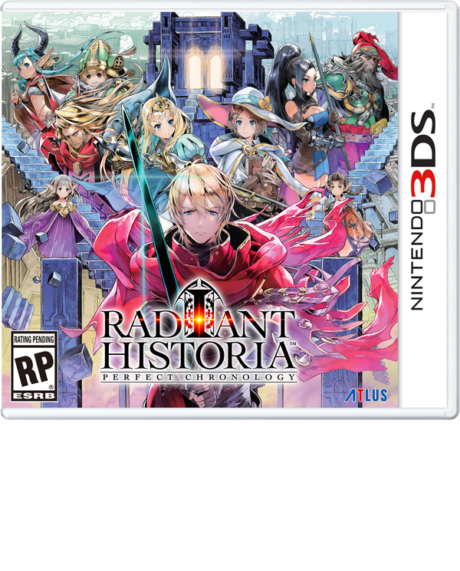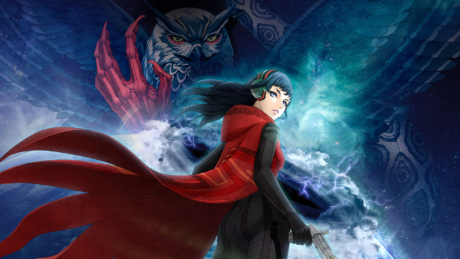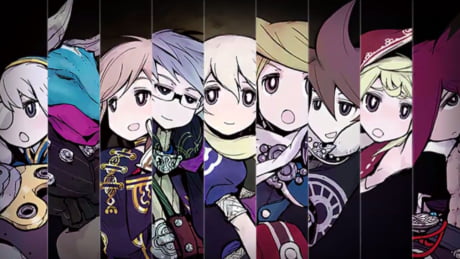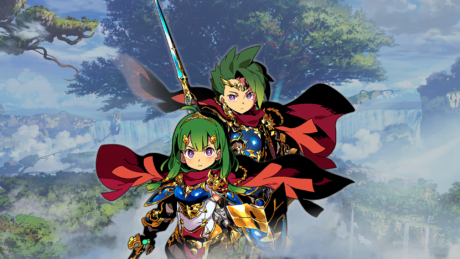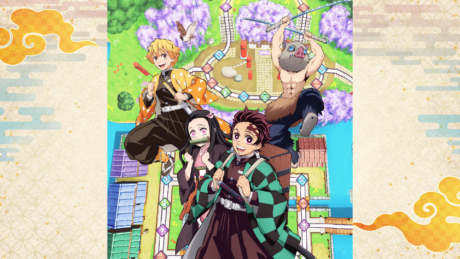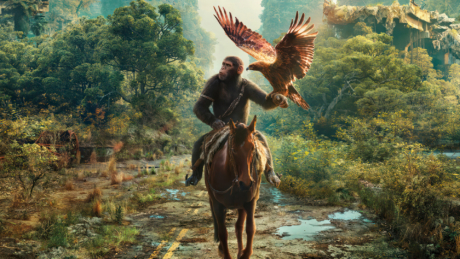Purrr....
- Combat
- Time travel
- Ideal for those unfamiliar with the original
Hisss!
- One-dimensional characters
- Historia needs to be in 3D
- Rosch’s rows and columns are backwards!
Platform
3DSPublisher
AtlusDeveloper
AtlusGenre
RPGPlayers
1File Size (Minimum)
1 GB (8,029 blocks)Release Date (NA)
Feb 13, 2018Radiant Historia: Perfect Chronology is a time-twistingly fun RPG with an engaging battle system and a few odd quirks.
A Stitch In Time Saves Nine
The world is slowly turning into desert, and Alistel and Granorg, two of the greatest nations on the continent of Vainqueur, are waging war over the ever-dwindling amount of fertile land.
Enter Stocke, a former military man and the top spy in Alistel’s Special Intelligence (SI) unit. He and his recently assigned subordinates have been sent on a mission to escort an Astellian agent with valuable information back home, but during the operation, the situation goes south. The agent, as well as Stocke’s companions are killed, and Stocke himself is badly injured in his escape.
As Stocke laments his failure, two child-like beings appear in front of him, revealing that he can change the past using the power of the White Chronicle, a mysterious book that had been given to him prior to the mission. With no other options, he accepts, travels back in time, and saves everyone’s lives using his knowledge from before. At this point, the two children reappear and give Stocke an even greater task: use the book to stop the desertification of the world or else all of humanity will perish. Furthermore, the fate of everything depends on Stocke’s next decision. No pressure.
Thankfully, he can go backward and redo it as many times as he needs to to get it right, so players will be going back and forth between the two timelines in order to right the world’s wrongs.
The Time Warrior
Saving the world is to be expected in virtually every RPG, but the idea of desertification and the fighting that arises from scarce resources speaks to timeless issues. Likewise, loner protagonists who eventually warm up to others are pretty standard–a stock character type, if you will–but Stocke is a guy who learns that lesson faster than most. (I guess watching your friends die in one timeline will do that.)
He’s joined in his time-traveling adventure by a colorful cast of characters, and by colorful, that is meant literally. Stocke’s costume, as well as that of his old army buddy, Rosch, is primarily red; Raynie’s is blue; Marco’s green; and so on. Even the two child-like beings who guide you, Teo and Lippti, are mostly orange and purple, respectively. Given that all the characters are rendered as small sprites on the game’s non-battle maps, it’s a good design choice because it makes them easy to recognize. (And don’t worry about ever confusing Stocke and Rosche; the latter is built like a tank, while the former is skinny.)

Their personalities are similarly straightforward and fairly one-dimensional: Raynie is the cheerful girl; Marco her confidante; Rosch the loner’s best friend, etc. Basically, you’ve seen these types before, but they’re done well. In addition, all the major characters are voiced in every cutscene with some solid acting for the genre. Heck, even a generic townsperson or soldier will elicit a vocal response of some sort, which is a nice touch. That said, on occasion, when Stocke is speaking to such a person, it’s a slightly weird effect when his lines are fully voiced, but the other character’s aren’t. Their one-word vocalizations aren’t them being curt; it honestly just comes off that way once in a while.
Anyway, you’ll encounter more than the aforementioned characters over the course of your journey, but only three can be placed in your active party at one time. Well, actually, only two since Stocke must always be a party member. (It would’ve been nice to switch him out from a gameplay perspective.) When new characters join you, their level will be roughly around yours, but some characters like Rosch are only available in a certain timeline. On the other hand, Raynie and Marco are always available as party members, and since their stats and equipment stay the same regardless of timeline, they’ll likely be at a much higher level than the others. As a result, you’ll either have to forego using the stronger characters in favor of leveling up the weaker ones or you’ll just end up leaving them on the sidelines. That said, when you’re on a particular timeline and have access to more than two characters, those not in your active party will earn experience points (XP), albeit at a much slower rate.
Each party member can be equipped with a weapon, a piece of armor, and three accessories. Unfortunately, you won’t earn much money from battles, so you won’t be able to afford to equip your party with the latest and greatest gear the first time you see it available from merchants throughout the world. However, this isn’t necessarily a bad thing since you have two timelines’ worth of equipment to keep in mind. Focus on one or two of the most urgent pieces, and you’ll be fine. You’ll find decent gear out in the world.

A Time to Explore
In town, as well as in dungeons, players control Stocke. He can do the standard actions of walking/running and talking to people, but over the course of the story, players will also be able to perform more actions like moving heavy boxes and detonating barrels in order to clear a path. Stocke can also slash his sword, which cuts down certain types of trees, but mostly, it’ll be used to stun enemies which appear on the dungeon map screen. These creatures patrol a small area and will give chase for a short distance in an attempt to start a battle, so slashing them is helpful when you’re in a hurry and want to avoid fighting. It can also be used to increase the chance for a pre-emptive attack if a battle is engaged. Of course, simply running around the enemy is also an option, and a successful escape will elicit a vocal response from a party member.
The world map itself acts as little more than a glorified menu. Players select where they want to go, and Stocke will slowly move to that point. Oddly enough, if he has to go from one location back to a previous one like Alistel, he will moonwalk back, instead of turning around and walking like a normal person.
Wibbly-Wobbly, Timey-Wimey
Traveling through time is handled by the White Chronicle, which is accessible at save points and on the world map screen. The book is essentially a map of all the possible outcomes across the two central timelines, and each event appears as a node once the player unlocks it over the course of a playthrough. (Nodes appear on the top screen, while descriptions of each appear on the bottom.) Places where the timeline branches appear as blue and purple nodes, while regular events are in brown and bad endings are in red. Blue and purple notes can be traveled to directly and can be redone as many times as is needed–and yes, that includes boss fights. Story cutscenes also replay each time you revisit a scene, but thankfully, they can be easily skipped with the touch of a button. The game also keeps track of how many nodes have been unlocked, and to get the best ending, you’ll want to want to unlock as many as possible.

Time travel does have its quirks, of course. Early on in the story, before I fully understood how the two timelines affected each other, I was stuck for a couple hours, not knowing what to do next. Eventually, I stumbled onto the answer, but I realized that things change not unlike the Light World and Dark Worlds in The Legend of Zelda: A Link to the Past. Saving a person in one timeline will somehow automatically save them in another timeline, even if that doesn’t really make sense from a normal point of view. Similarly, if a chest is opened in the future, that same chest will still be opened even if you go back into the past. Gameplay-wise, it’s fine but a bit loopy otherwise.
Of course, in real life, the weekend I spent playing this game disappeared much quicker than it should have. Did I really spend twenty hours on it during those two days?
Whose Line Is It Anyway?

Battles in Radiant Historia make use of a grid battle system that’s built upon a strong, turn-based foundation. As such, the main action takes place on the top screen, while the bottom screen shows the battle order of both characters and enemies.
Your characters always stand in one column on the right side of the top screen, while the enemy stands on the left side in a three-by-three grid. Enemies who stand closer to you deal more damage, but they also take more damage, too. They can also move to an adjacent square once per turn. You, on the other hand, cannot move your characters, but what you can do is to forcibly move enemies around their grid. Basically, any enemies that occupy the same square in the grid take damage together. Moreover, when party members attack in succession, you create a combo that deals extra damage, as well as give more money and XP at the end of the battle. Therefore, it’s to your great benefit to figure out the best way to get as many foes as possible in one square and then unleash a massive series of attacks.
To do this, your party members have various skills which manipulate an enemy’s location on the grid, including pulling them forward, pushing them back, and moving them left and right. As noted before, knocking enemies into one another will allow you to set them up for later damage, but if there isn’t another one in the path when you move them, they will be sent flying to the edge of the grid. Using these skills also cost magic points (MP), so given the fact that you’ll be moving enemies around in almost every single battle, be prepared to carry a ton of MP recovery items or make frequent trips to the inn. (As a third option, you could also take advantage of the time-hopping mechanic to rest at a certain location for free.) As another downside, not every character knows the various movement skills by default. Raynie and Marco, for example, actually have to find scrolls hidden throughout the world in order to learn all the directional moves.
However, moving enemies around isn’t always needed. Some characters can hit multiple enemies in different formations, while others can lay traps, both negating the need to move foes. That said, in a bizarre error in this reviewer’s opinion, Rosch’s row- and column-based attacks are incorrectly reversed. Normally, if you saw a description that said it would affect an entire row, you’d expect it to appear on-screen as being left-to-right. Not so. In the game, it appears as a column, as though it were from the character’s perspective and not yours as a player’s. It’s a minor thing, but considering how important location is in these battles, it’s needlessly confusing.
Combos, as mentioned, require your characters to attack one right after another. Considering that your party only consists of three members, it can be difficult to rack up high counts for maximum damage. However, there are a few ways to increase the number of hits. First is using different physical and magical skills. Second is using pre-emptive strikes, but these aren’t guaranteed to work every time. Third is using the Change skill to modify the battle order. However, doing so makes you more vulnerable to critical hits and status effects like poison. Fourth is to use the Mana Burst skill to delete an enemy turn from the battle order. This skill isn’t learned until several hours into the game and requires you to first fill the Mana Gauge with other combo attacks. Finally, there’s the random instance of support characters. If you have a character available in the timeline who isn’t in the active team and knows a support skill, he or she will occasionally appear without warning and perform an action. They won’t interrupt with location manipulation, and the extra hit or spell is usually beneficial.
Honestly, it’s a lot of work to keep track of all these battle elements going on. Fortunately, the battle order includes information about what move you’re having each character make in each turn. That said, there have been more than a few times where I had to stop for a minute, delete moves, and then re-enter them because I’d lost track of what I was doing.
Another Place Another Time
The original Radiant Historia came out on the Nintendo DS six years ago, but for the 3DS release, the graphics were cleaned up and the artwork redone. Overall, the game looks decent enough and does its job, but nothing really stands out, figuratively or literally. If nothing else, Historia, a white-surfaced location that stands outside of time and space and features mystical floating stairways, begs to be given the 3D treatment. Having just that area in 3D would emphasize its otherworldliness, but alas, ‘tis not the case.
As far as new features go, Perfect Chronology offers a Perfect Mode for players already familiar with the story and incorporates new content into it. For those new to the title, these extras are unlocked after the game is completed. Downloadable Content is also available for purchase, expanding the time-twisted tale even further.
The soundtrack by Kingdom Hearts and Mario & Luigi composer Yoko Shimomura is a solid entry into the composer’s body of work, hitting all the notes you’d expect from a classic-feeling RPG. Regal themes swell in the traditional kingdom of Granorg, while Allistel is more fitting for a nation that runs on magical technology. Sinister music plays with the villains, and the battle-theme thumps ever-on, urgent without being overwhelming.
As far as sound effects go, I will only say one thing. I will never forget how a goblin screams. Ever.
Time Enough At Last
Overall, Radiant Historia: Perfect Chronology is a time-twistingly fun RPG with an engaging battle system and a few odd quirks. It’s the most perfect version we’ll get…unless Atlus announces something for the Nintendo Switch.
Disclaimer: A digital review copy was provided by Atlus USA.
